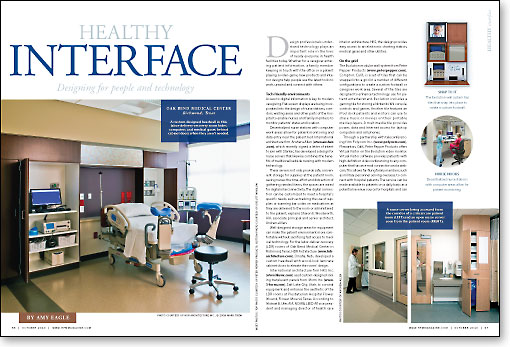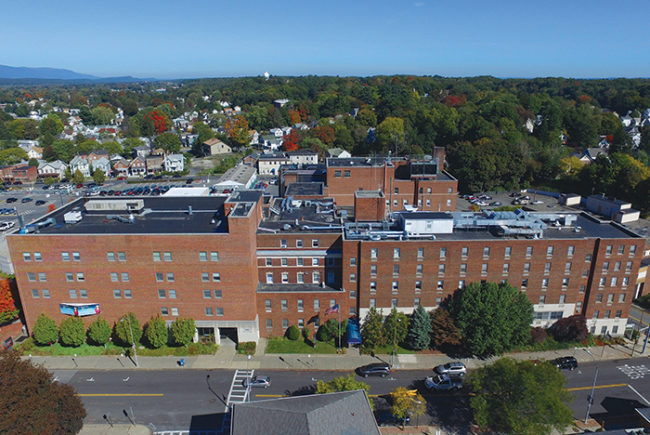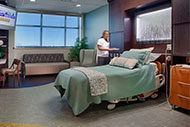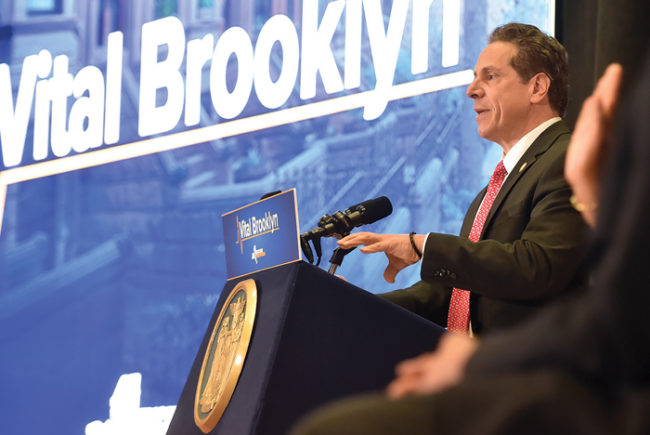Download Healthy Interface (PDF)
Design professionals understand technology plays an important role in the lives
of nearly everyone in health facilities today. Whether for a caregiver entering patient information, a family member keeping in touch with the office or a patient playing a video game, new products and interior designs help people use the latest tools to work, unwind and connect with others.
Tech-friendly environments
Access to digital information is key to modern caregiving. Flat-screen displays are being incorporated into the design of nurse stations, corridors, waiting areas and other parts of the hospital to enable nurses and family members to monitor patients' status and location.
Decentralized nurse stations with computer work areas allow for patient monitoring and data entry near the patient bed. International architecture firm Anshen+Allen (www.anshen.com), which recently signed a letter of intent to join with Stantec, has developed a design for nurse servers that likewise combines the benefits of traditional bedside nursing with modern technology.
These servers not only provide safe, convenient storage for supplies at the patient room, saving nurses the time, effort and distraction of gathering needed items, the spaces are wired for digital interconnectivity. The digital connection can be customized to meet a hospital's specific needs, such as tracking the use of supplies or scanning bar codes on medications as they are delivered to the room or administered to the patient, explains Sharon E. Woodworth, AIA, associate principal and senior architect, Anshen+Allen.
Well-designed storage areas for equipment can make the patient environment more comfortable without sacrificing fast access to medical technology. For the labor-deliver-recovery (LDR) rooms of Oak Bend Medical Center in Richmond, Texas, HDR Architecture (www.hdrarchitecture.com), Omaha, Neb., developed a custom headwall with wood-look laminate cabinet doors to elevate the rooms' design.
International architecture firm HKS Inc. (www.hksinc.com) used custom-designed sliding translucent panels from 3form Inc. (www.3-form.com), Salt Lake City, Utah, to conceal equipment and enhance the aesthetic of the LDR rooms at Presbyterian Hospital Flower Mound, Flower Mound, Texas. According to Michael B. Ufer, AIA, NCARB, LEED AP, vice president and managing director of health care interior architecture, HKS, the design provides easy access to an electronic charting station, medical gases and other utilities.
On the grid
The Evolution modular wall system from Peter Pepper Products (www.peterpepper.com), Compton, Calif., is a set of tiles that can be snapped into a grid in a number of different configurations to create a custom footwall or caregiver work area. Several of the tiles are designed to enhance technology use for patient entertainment. Evolution includes a gaming tile for storing a Nintendo Wii console, controls and games. Another tile features an iPod dock patients and visitors can use to share music or movies on their portable media players. A multimedia tile provides power, data and Internet access for laptop computers and cell phones.
Through a partnership with teleconferencing firm Polycom Inc. (www.polycom.com), Pleasanton, Calif., Peter Pepper Products offers Virtual Visitor on the Evolution video monitor. Virtual Visitor software provides patients with high-definition videoconferencing to any computer that has an e-mail connection and a webcam. This allows far-flung family members, such as military personnel serving overseas, to connect with hospital patients. The service can be made available to patients on a daily basis as a potential revenue source for hospitals and can be used by physicians for videoconference consultations.
The Evolution monitors also can be integrated with a hospital's information system for use with electronic medical records.
Exact time keeping is important for time-sensitive nursing tasks, accurate patient records and reduced hospital liability. The Evolution clock tile can be used with Peter Pepper Products' SyncTech Time System, which controls system clocks with a master transmitter that wirelessly broadcasts the current time. The Federal Communications Commission-licensed business frequency does not interfere with medical telemetry equipment. The system's lithium clock batteries, which can last up to 10 years each, and its automatic updates for daylight savings time can lower a facility's maintenance costs.
The Evolution system requires no exposed power or data cords; a power tile manages all necessary wiring internally.
Accommodating features
The Pocket line of mobile workstations from Nurture (www.nurture.com), the health care division of Grand Rapids, Mich., furniture manufacturer Steelcase Inc., is designed to be used with a variety of technologies, including tablet computers, laptops, desktops, and even pen and paper. Nurture designed Pocket in collaboration with Modo (www.modocarts.com), a cart manufacturer based in Portland, Ore.
"Obviously, technology is in transformation. We're going from laptops to tablets; there are other hand-held devices used in health care. Who knows what's going to be the most common medium in even a couple years? We wanted to have a very simple interface that could accommodate these different technologies," says Alan Rheault, Nurture's director of product development.
Pocket mobile workstations feature moveable magnetic accessories that allow caregivers to customize them instantly. The Pocket line also offers height-adjustable workstations.
The Cahoots series of lounge furnishings from Toronto-based furniture manufacturer Keilhauer (www.keilhauer.com) adapts to the various ways people interact with technology and one another in public spaces. The modular system was introduced at this year's NeoCon World's Trade Fair in Chicago, where it won the Best of NeoCon gold award for lounge seating. The line was designed by Austrian product, furniture and architectural design firm EOOS (http://eoos.net).
The Cahoots Work chair and Notebook table fit together to create a comfortable space for using a laptop or netbook computer. The Relax chair is designed for the informal postures people tend to assume while talking on cell phones or using mobile e-mail or smart-phone devices. The chair's wireframe base "easily accommodates somebody putting their legs over one side of the arm and leaning back on the other arm in a very casual position," says Marilyn Maxim, manager, marketing and public relations, Keilhauer. Because people often eat while using these devices, the Cahoots side chairs have a space between the seat and back that allows crumbs to fall to the floor rather than become trapped in the chairs, where they would be more difficult to clear away.
Human-centered design
While technology is pervasive in health care environments — and nearly every other environment today — the best designs concentrate on the needs of people, to help them use technology effectively. As Alan Rheault, of Nurture, notes, human-centered design is especially important in health care, which is "just about as human-centered as you can be."






